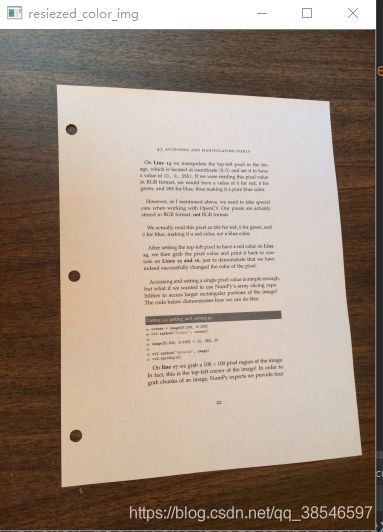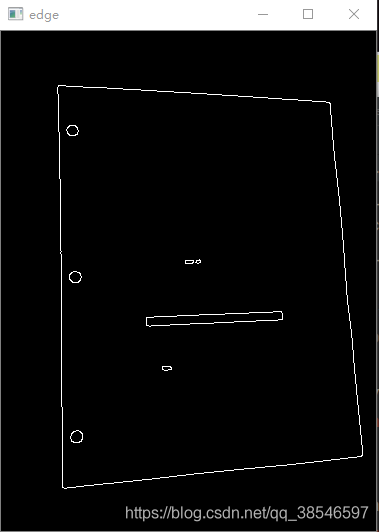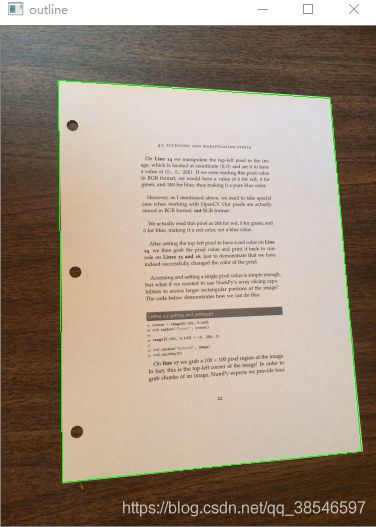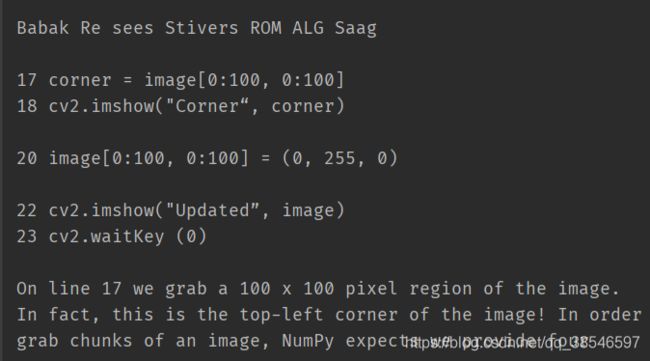python使用opencv实现文档扫描并提取文字
目的
将输入文档使用透视变换将不规则图形变换,然后使用tesseract库进行识别文字
变换前图形
变换后图形
步骤
1.加载原图并显示
2.重新调整大小

3.灰度处理

4.滤波

5.边缘检测

6.找出轮廓

7.透视变换
主要的步骤:
需要变换前pst1和变换后的4个坐标点pst2:这里可以使用图形的4个顶点
使用函数获得M矩阵
pts1 = np.float32([[56,65],[368,52],[28,387],[389,390]])
pts2 = np.float32([[0,0],[300,0],[0,300],[300,300]])
M = cv.getPerspectiveTransform(pts1,pts2)
根据M矩阵获得变换后的图形矩阵
dst = cv.warpPerspective(img,M,(300,300))
根据修改好的图形使用tesseract库来识别图中文字

代码实现
图形处理模块
import cv2 as cv
import numpy as np
import math
import pytesseract
def resized_img(img, width=None, height=None, inter = cv.INTER_AREA):
"""
等比例重新调整大小
:param img:
:param width: 宽度整数
:param height: 高度整数
:param inter:
:return: 返回调整后的图形矩阵
"""
# 如果宽高都为0
if height is None and width is None:
return img
h,w = img.shape[:2]
# print(w,h)
# 同比例放缩图 形
prop = w/h
# print(prop)
if height is not None and width is not None: # 宽高都给定
return cv.resize(img,(width,height),interpolation=inter)
elif height is not None:# 给定高度计算宽度
w = int(height*prop)
return cv.resize(img,(w,height),interpolation=inter)
else:
h = int(width/prop)# 给定宽度计算高度
# print(h)
return cv.resize(img,(width,h),interpolation=inter)
def show(img, name="image", model=0):
"""
:param img:
:param name:
:param model: 是否可以缩放图片
:return:
"""
if model == 0:
cv.namedWindow(name, cv.WINDOW_NORMAL)
cv.imshow(name, img)
cv.waitKey(0)
cv.destroyAllWindows()
def order_point(contour):
"""
对输入的4个坐标进行排序
分别为左上,右上,右下,左下
:param contour:
:return:
"""
# contour(4,1,2)
print(contour.shape)
print(contour)
rect = np.zeros((4,2), dtype=np.float32)
s = contour.sum(axis=1)
print(s)
sort_s = sorted(s, key=lambda x:x[0])
left = sort_s[:2]
left_sort = sorted(left, key=lambda x:x[1])
rect[0] = left_sort[0]
rect[3] = left_sort[1]
right=sort_s[2:4]
right_sort = sorted(right, key=lambda x:x[0])
rect[1] = right_sort[0]
rect[2] = right_sort[1]
return rect
def new_point(origin):
"""
根据原始的4个点位置得到新的4个对应点的位置
:param origin:
:return:对应宽高 以及目标4个位置
"""
top_left, top_right, bottom_right, bottom_left = origin
# print(top_left,top_right,bottom_right,bottom_left)
# 根据输入的坐标计算新的坐标
w1 = math.sqrt(((top_right[1]-top_left[1])**2)+((top_right[0]-top_left[0])**2))
w2 = math.sqrt(((bottom_right[1]-bottom_left[1])**2)+((bottom_right[0]-bottom_left[0])**2))
print(w1,w2)
w = int(max(w1, w2))
h1 = math.sqrt(((top_right[1]-bottom_right[1])**2)+((top_right[0]-bottom_right[0])**2))
h2 = math.sqrt(((top_left[1] - bottom_left[1]) ** 2) + ((top_left[0] - bottom_left[0]) ** 2))
print(h1,h2)
h = int(max(h1,h2 ))
dst = np.array(
[
[0, 0],
[w - 1, 0],
[w - 1, h - 1],
[0, h - 1],
],dtype=np.float32
)
return (w,h),dst
def ocr_preprocess():
"""对输入图像进行变换成规矩的图形"""
# 加载原彩色图
image = cv.imread("image/ocr_recoginze/page.jpg")
show(image, name="image", model=0)
print(image.shape)
# 对图像缩放用于测试方便观察
ration = image.shape[0]/500
print(ration)
resiz_color_img = resized_img(image, height=500)
show(resiz_color_img, name="resiezed_color_img", model=1)
print(resiz_color_img.shape)
# 原图进行后续操作
# resiz_color_img = image
# 转化为灰度图
gray = cv.cvtColor(resiz_color_img, cv.COLOR_BGR2GRAY)
show(gray, name="gray", model=1)
# 滤波操作
gray = cv.GaussianBlur(gray,(5,5),0)
show(gray, name="gauss", model=1)
# 边缘检测
edge = cv.Canny(gray, 100, 200, apertureSize=3)
print(edge)
show(edge, name="edge", model=1)
# 边缘检测过后已经是二值化的图像
# 进行轮廓提取
contours, hierarchy = cv.findContours(edge, cv.RETR_EXTERNAL, cv.CHAIN_APPROX_SIMPLE)
# 找到最大的5个轮廓
contours = sorted(contours, key=cv.contourArea, reverse=True)[:5]
print(len(contours))
fit_controus = []
# 轮廓近似
for contour in contours:
arclen = cv.arcLength(contour,closed=True)
epsilon = 0.01*arclen
approx = cv.approxPolyDP(contour, epsilon=epsilon, closed=True)
# 轮廓近似为4个点
if len(approx) == 4:
fit_controus.append(approx)
break
# 画出轮廓
cv.drawContours(resiz_color_img, fit_controus, -1 ,(0,255,0),1)
show(resiz_color_img, name="outline", model=1)
# 透视变换
for contour in fit_controus:
# 原始图像4个点的位置
print("原始:",contour)
print("ration后的:",ration*contour)
origin = order_point(contour*ration)
# 对应变换后的4个点的位置
size, dst = new_point(origin)
print(size)
# 获得变换矩阵
perspect_matric = cv.getPerspectiveTransform(origin, dst)
print(perspect_matric)
# 得到变换后的图像矩阵
wraped = cv.warpPerspective(image,M=perspect_matric,dsize=size)
show(wraped, name="wraped")
cv.imwrite("my_page.png", wraped)
if __name__ == '__main__':
ocr_preprocess()
图形识别模块
import pytesseract
from PIL import Image
# fp = open("my_page.png",'br')
text = pytesseract.image_to_string(Image.open("my_page.png"))
print(text)